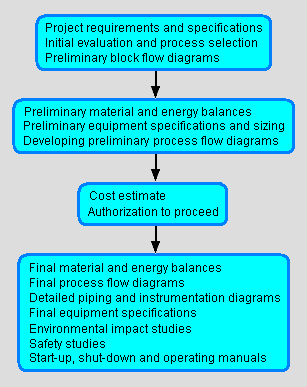Process design: Difference between revisions
imported>Milton Beychok m (Process design (chemical engineering) moved to Process design: After a thorough Google search of CZ articles, there is no need (now or in the foreseeable future} for any disambiguation of "process design".) |
mNo edit summary |
||
| (One intermediate revision by one other user not shown) | |||
| Line 1: | Line 1: | ||
{{subpages}} | {{subpages}} | ||
{{TOC|right}} | {{TOC|right}} | ||
'''Process design''' in the field of [[chemical engineering]] is the design of industrial processes to produce desired physical and/or chemical transformation of substances. Process design is central to [[chemical engineering]] and it integrates most of the basic components of that field. The design starts at a conceptual level and ends with the writing of specifications for fabricating the process equipment items and development of documents needed for construction of the overall processing facility.<ref name=Sinnott>{{cite book|author=R.K. Sinnott|title=Chemical Engineering Design|edition=4th Edition|publisher=Butterworth-Heinemann|year=2005|id=ISBN 0-7506-6538-6}} Volume 6 of Coulson & Richardson's Chemical Engineering Series</ref><ref name=Silla>{{cite book|author=Harry Silla|title=Chemical Process Engineering Design and Economics|edition=1st Edition|publisher=Marcel Dekker|year=2003|id=ISBN 0-8247- | '''Process design''' in the field of [[chemical engineering]] is the design of industrial processes to produce desired physical and/or chemical transformation of substances. Process design is central to [[chemical engineering]] and it integrates most of the basic components of that field. The design starts at a conceptual level and ends with the writing of specifications for fabricating the process equipment items and development of documents needed for construction of the overall processing facility.<ref name=Sinnott>{{cite book|author=R.K. Sinnott|title=Chemical Engineering Design|edition=4th Edition|publisher=Butterworth-Heinemann|year=2005|id=ISBN 0-7506-6538-6}} Volume 6 of Coulson & Richardson's Chemical Engineering Series</ref><ref name=Silla>{{cite book|author=Harry Silla|title=Chemical Process Engineering Design and Economics|edition=1st Edition|publisher=Marcel Dekker|year=2003|id=ISBN 0-8247-4274-5}}</ref> | ||
Process design includes the modification or expansion of existing industrial facilities as well as the design of new industrial facilities. | Process design includes the modification or expansion of existing industrial facilities as well as the design of new industrial facilities. | ||
| Line 60: | Line 60: | ||
==References== | ==References== | ||
{{reflist}} | {{reflist}}[[Category:Suggestion Bot Tag]] | ||
Latest revision as of 12:00, 7 October 2024
Process design in the field of chemical engineering is the design of industrial processes to produce desired physical and/or chemical transformation of substances. Process design is central to chemical engineering and it integrates most of the basic components of that field. The design starts at a conceptual level and ends with the writing of specifications for fabricating the process equipment items and development of documents needed for construction of the overall processing facility.[1][2]
Process design includes the modification or expansion of existing industrial facilities as well as the design of new industrial facilities.
Although chemical engineering is involved in the design of many equipment items used in industrial chemical processes, equipment design is not usually included in process design.
Process design diagrams and other documents
Process design documents serve to define the design and they ensure that the design components fit together. They are useful in communicating ideas and plans to other engineers involved with the design, to external regulatory agencies, to equipment vendors and to construction contractors.
In order of increasing detail, process design documents include:[1][2]
- Block Flow Diagrams (BFDs): Very simple diagrams indicating major material and/or energy flows.
- Process Flow Diagrams (PFDs: Typically more complex diagrams of major unit operations that include the key equipment items as well as the key flow lines. They usually include a material balance, and sometimes an energy balance, listing typical or design flow rates, key stream compositions, and the pressures and temperatures of the key stream and equipment items. A PFD may include the amount of heat to be provided by any process furnaces as well as the amount of heat exchanged by any process heat exchangers and distillation reboilers.
- Piping and Instrumentation Diagrams (P&IDs): Diagrams showing all major and minor equipment items as well as each and every pipeline with piping class (e.g., carbon steel or stainless steel) and pipe size (diameter). They also show all valving along with all instrument locations and process control systems.
- Equipment specifications: Written design requirements of all major equipment items.
Process designers also typically write operating manuals on how to start-up, operate and shut-down the process.
After construction and initial start-up operation of the process facility, the process design documents are retained by the facility management and operating personnel for future reference as may be needed. The documents are also useful when facility modifications or expansions are planned.
Design Considerations
Designs have objectives and constraints, and even a simple process requires a trade-off among such factors.
Objectives that a process design strives to include:
- Throughput rates
- Product yields
- Product purities
Constraints that must be accommodated:
- Capital cost
- Available space
- Safety concerns
- Environmental impact and projected wastewater effluents, air pollutant emissions and production of solid wastes.
- Operating and maintenance costs
Other factors that designs may take into consideration are:
- Equipment redundancy to improve operational reliability and flexibility.
- Anticipated variability in feedstock and allowable variability in product.
Sources of Design Information
Designers rarely start from scratch, especially for complex projects. Often the engineers have pilot plant data available or data from full-scale operating facilities. Other sources of information include proprietary design criteria provided by process licensors, published scientific data, laboratory experimental data and input.
Computer Help
The advent of low cost powerful computers has aided complex mathematical simulation of processes, and simulation software is often used by design engineers. Simulations can identify weaknesses in designs and allow engineers to choose better alternatives.
However, engineers still rely on experience, logic and intuition when designing a process. Human creativity is still an important element in complex designs.
References
- ↑ 1.0 1.1 R.K. Sinnott (2005). Chemical Engineering Design, 4th Edition. Butterworth-Heinemann. ISBN 0-7506-6538-6. Volume 6 of Coulson & Richardson's Chemical Engineering Series
- ↑ 2.0 2.1 Harry Silla (2003). Chemical Process Engineering Design and Economics, 1st Edition. Marcel Dekker. ISBN 0-8247-4274-5.
